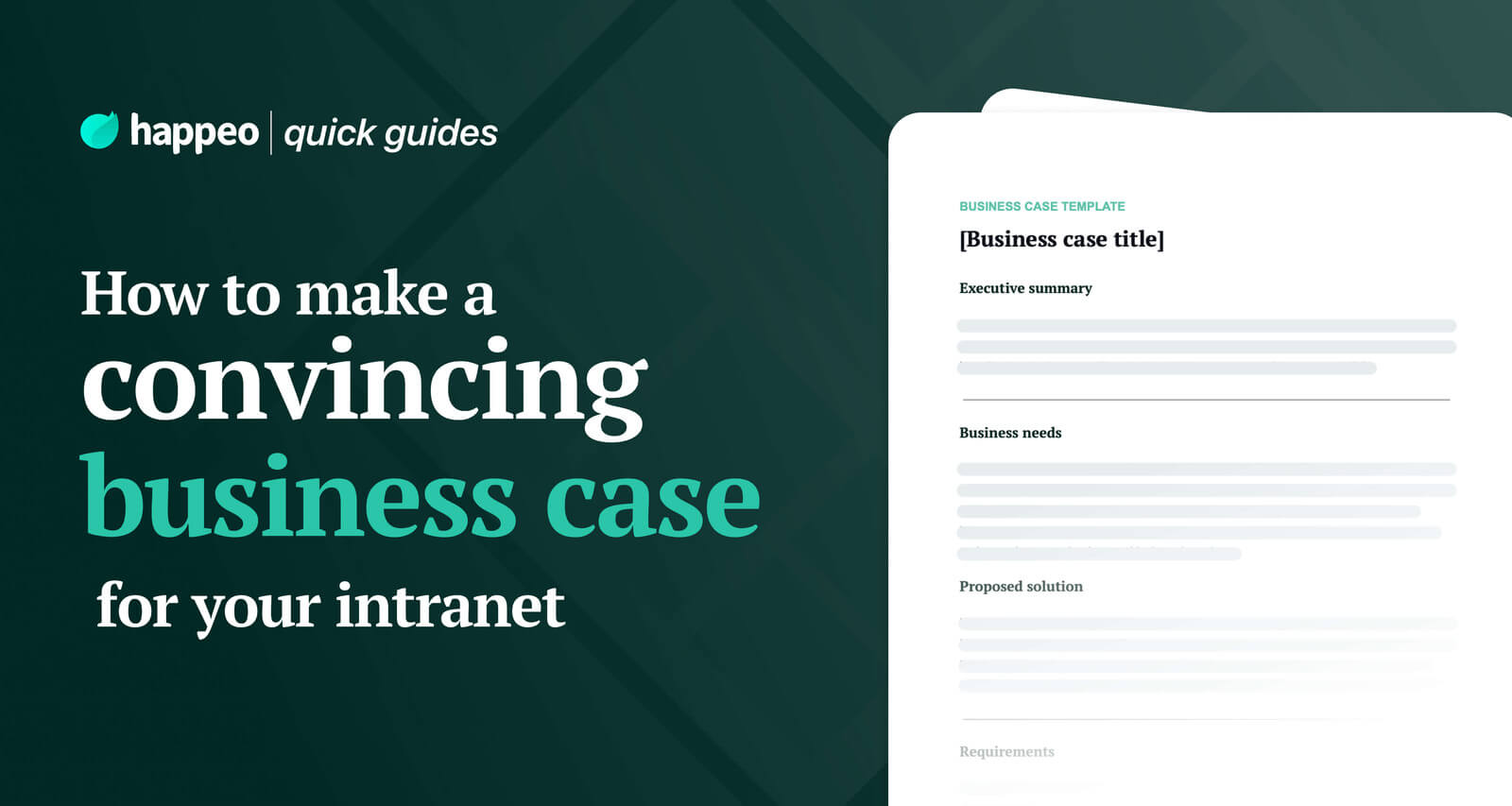
Quick guides
How to make a convincing business case for your intranet

10 mins read
Start building your digital home with Happeo
Request a demoQuick guides
Product
Features
Solutions
Happeo for
Use cases
Resources
Explore
Support
Happeo For
Use cases
Comparisons
Explore
Support
Recent

Vivian Zhou
10 mins read
Quick jump to
Finding an intranet that ticks all of the right boxes for your organization is no mean feat. That’s true whether you’re a corporation with thousands of employees or a small business with a headcount of less than 50.
And unfortunately, even when you’ve found the right solution, convincing the decision-makers in your organization to invest in an intranet is often no cakewalk either.
If you need some help getting your organization’s leadership on board with your intranet project, don’t worry. This article will take you through everything you need to know to build a solid business case for your intranet. If you do it right, you can not only convince your leadership team that your project is the right investment choice, but even get them excited about it too.
Before you can start building a business case for your intranet, you need to know what you’re up against. That means figuring out exactly why decision-makers might be against buying an intranet in the first place. After all, while an intranet can provide many benefits to an organization, there are some downsides too. For example:
Company leaders make purchasing decisions that align with their organization's goals and needs. They consider the potential benefits of new software and weigh them against the risks and costs involved. That means that any investments that incur a high risk and cost will raise concern and opposition — unless you can prove that the benefits outweigh them.
So, how do you convince the higher-ups that investing in an intranet is a smart choice for your organization? The best way is to create a business case that they just can’t say no to. A good business case should outline all of the potential benefits, costs, and risks of your proposed project — and show that it’s the right choice to make.
Here are some of the reasons you need to build a business case for your intranet:
Overall, a business case is an important tool for ensuring that a proposed project is well thought-out, financially feasible, and aligned with the organization's goals. A well-prepared business case provides decision-makers with a comprehensive view of the potential impact a project could have on their organization, and helps them to make informed decisions. That means that if you put the time and effort into building a solid business case, you’ll have a much better chance of winning their blessing for your intranet project.
What does a business case look like, anyway? Well, a good one will usually include the following elements:
If you want to present a persuasive argument for an intranet, you’ll need to take the time to craft a well-thought-out, comprehensive business case. Here are the steps to follow to put your business case together:
The first step is to clearly define the problem or need that the intranet aims to resolve. For example, you might need an intranet because you need to improve communication and collaboration, or save time by streamlining manual tasks.
Next, take the time to thoroughly research various intranet solutions and platforms to determine the best fit for your company. If your system is based on Google Workspace or Microsoft 365, you might want to consider those that can integrate seamlessly into your existing ecosystem.
Next, you’ll need to identify the key stakeholders and their stakes in the project. That means identifying not only the final decision-makers but also any other influencers and gatekeepers that you might have to win over. To do this, you should seek to understand their pain points and how your solution addresses them. You should also perform a detailed cost-benefit analysis so that you can make your business case more relevant and persuasive to all of the stakeholders involved.
Once you’ve identified your stakeholders, it’s time to outline the steps you’ll take to launch the intranet. This includes planning for any necessary hardware and software purchases, the training you’ll deliver to employees, and how you’ll continue to support them once it’s up and running.
You’ll then need to identify any potential risks and challenges that might arise — and create a plan to mitigate or address them.
Finally, establish the governance structure for managing content, access, and security, and decide who will manage and maintain the intranet. Set out the KPIs you’ll use to measure the success of the project.
Once your business case is approved, there’s still one last hurdle to get over: presenting it to key stakeholders and decision-makers. This can be a nerve-wracking moment — but it’s also your biggest shot at convincing them that investing in an intranet is a good idea.
Here are our tips to help you ace it.
Here’s the thing: people love talking about themselves and their needs — and they often only hear what they want to hear. That means that the sooner you understand that talking to someone isn't about what you have to say, but about what they want to hear, the faster you'll be able to persuade them. Start with questions instead of diving straight into a pitch, and try to find out what's on your audience’s agenda and what pain points and challenges they’re facing. This allows you to connect your presentation to the things that matter to them.
It’s important to know which business benefits your stakeholders are going to be focusing on in the near future so that you can align your approach with them. More generally, your pitch should detail all of the problems that the intranet could solve, even if they’re not perfectly quantified. For example, you can’t know exactly how much a security leak would cost your business — but you know it’s something you want to avoid. Think about who will benefit from your intranet project across your entire organization, and make sure you include those benefits in your presentation. This makes it clear that it isn’t just about you and your department.
After you've shown your audience that you want to listen to them, that you understand the business, and that you know what you're talking about, it's time to open up. This means talking directly about how much easier an intranet will make your job. After all, an intranet can be a powerful tool for driving communication and collaboration across an entire company. If you’ve got as far as building a business case for your intranet, you already know you need one. This is the moment to show your audience why you do, by approaching it from the micro level.
The best salespeople are the ones that truly believe that what they're selling is the best solution to a problem. Of course, there are practical things to consider, like making sure you have the data you need to back up your claims. But the most important thing is to make sure you’re 100% convinced that you’ve found the right solution before you start trying to convince anyone else.
A business case is your chance to make a compelling case for why your idea is a business opportunity worth pursuing. So, bring your A+ game, get creative, and show your company’s leaders why this investment is the right one to make. Download the business case template here.
